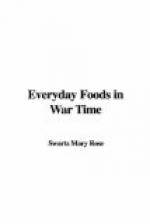Milk will take the place of bread, butter, sugar, and other foods used chiefly for fuel. The body is an engine which must be stoked regularly in order to work. The more work done the more fuel needed. That is what we mean when we talk about the food giving “working strength.” A farmer and his wife and usually all the family need much fuel because they do much physical work. Even people whose work is physically light require considerable fuel. A quart of milk will give as much working force as half a pound of bread, one-fourth of a pound of butter, or six ounces of sugar. And this is in addition to the other advantages already mentioned.
Milk contains specifics for growth. Experiments with animals have taught us that there are two specific substances, known as vitamines, which must be present in the diet if a young animal is to grow. If either one is absent, growth is impossible. Both are to be found in milk, one in the cream and the other in the skim milk or whey. For this reason children should have whole milk rather than skim milk. Of course, butter and skim milk should produce the same result as whole milk. Eggs also have these requisites and can be used to supplement milk for either one, but as a rule it is more practical to depend upon milk, and usually more economical.
For little children, milk is best served as a beverage. But as children grow up, the fluidity of milk makes them feel as if it were not food enough and it is generally better to use it freely in the kitchen first, and then, if there is any surplus, put it on the table as a beverage or serve it thus to those who need an extra supply—the half-grown boys, for instance, who need more food in a day than even a hard-working farmer.
A good plan is to set aside definitely, as a day’s supply, a quart apiece for each person under sixteen and a pint apiece for each one over this age. Then see at night how well one has succeeded in disposing of it. If there is much left, one should consider ways of using it to advantage. The two simplest probably are, first, as cream sauce for vegetables of all sorts; for macaroni or hominy with or without cheese; or for hard cooked eggs or left-over meats; and next in puddings baked a long time in the oven so that much of the water in the milk is evaporated. Such puddings are easy to prepare on almost any scale and are invaluable for persons with big appetites because they are concentrated without being unwholesome.
The milk pitcher and the vegetable garden are the best friends of the woman wishing to set a wholesome and economical table. Vegetables supplement milk almost ideally, since they contain the vegetable fiber which helps to guard against constipation, and the iron which is the lacking door in the “house that milk built.”




